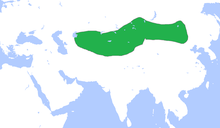Turkic Khaganate (552–630), (682-744), Tang China (630-682)
Northern Wei was disintegrating rapidly because of revolts of semi-tribal Tuoba military forces that were opposed to being sinicized, when disaster struck the flourishing Rouran Khaganate. The Altai Turkics (Orkhon Turkics, Göktürks), known as Tujue to Chinese chroniclers, were subjects to the Rouran and served as blacksmiths for them. In 552 AD the Göktürks revolted against their Rouran rulers. The uprising began in the Altai Mountains, where many of the Türk were serfs working the iron mines. Therefore, the revolt of the Turkics of 552 is often called the "Blacksmiths' rebellion". The uprising was headed by Buman, who became the founder of the Göktürk Khaganate. Thus, from the outset of their revolt, they had the advantage of controlling what had been one of the major bases of Rouran power. Between 546 and 553, the Türks overthrew the Rouran and established themselves as the most powerful force in Central Asia.
The Chinese dynasties Qi and Zhou surrendered in 570 and began paying tribute to the Göktürks. However, the newly established Sui dynasty in China (581) stop and so constant war between Sui and the Turkic Khaganate began. Turk was partitioned in 583 into an Eastern and Western Turkic Khaganates by the plot made by Sui dynasty of China . Finally in 584 Eastern Turk recognised Sui Suzerainty. Turkic Khaganate began to revolt and hasten the border in 615 after Emperor of Sui's failure expedition in Koguryo. The internal struggle between the Turkic nobles lead to their defeat by the Tang dynasty of China in 630. From 629 to 648, a reunited China—under the Tang dynasty (618-906) --destroyed the power of the Eastern Türk north of the Gobi; established suzerainty over the Khitan, a semi-nomadic Para-Mongolic people who lived in areas that became the modern Chinese provinces of Heilongjiang and Jilin; and established the Anbei Protectorate in the Mongolian Steppes. Uyghurs khagan was installed as Anbei protector, who inhabited the region between the Altai Mountains and Khitan's land. Between 641 and 648, the Tang conquered the Western Türk, reestablishing Chinese sovereignty over Xinjiang and exacting tribute from west of the Pamir Mountains. The Göktürks continuously struggled against the subjugation by the Tang dynasty started in 679. An uprising of 682 under the leadership of Kutuluk and Tonyukuk led to restoration of the Turkic Khaganate.
For a brief period at the beginning of the 7th century, a new consolidation of the Türk, under the Western Türk ruler Tardu, again threatened China. In 601 Tardu's army besieged Chang'an (modern Xi'an), then the capital of China. Tardu was turned back, however, and, upon his death two years later, the Türk state again fragmented. The Eastern Türk nonetheless continued their depredations, occasionally threatening Chang'an. In the early 8th century, an invading army of 450,000 soldiers headed by Tang dynasty's Empress Wu Zetian was defeated and chased back by Mojo khagan.[20] The Türk empire finally ended in 744 by the joint Chinese, Uighur and other nomadic forces.


No comments:
Post a Comment